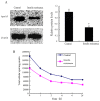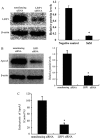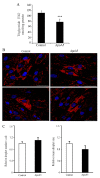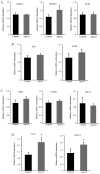Apolipoprotein A5 regulates intracellular triglyceride metabolism in adipocytes
- PMID: 28901468
- PMCID: PMC5865834
- DOI: 10.3892/mmr.2017.7461
Apolipoprotein A5 regulates intracellular triglyceride metabolism in adipocytes
Abstract
It has previously been demonstrated that apolipoprotein A5 (apoA5) can be internalized by human adipocytes and significantly decreases intracellular triglyceride content. In the present study, endocytosis of apoA5 by adipocytes under different conditions, and the underlying mechanism by which apoA5 regulates cellular triglyceride storage, was investigated. The results revealed that the apoA5 protein was detected in human subcutaneous abdominal adipose tissues. In addition, the uptake of apoA5 was attenuated in human obese adipose tissues and in cultured adipocytes with hypertrophy or insulin resistance. Low‑density lipoprotein receptor protein 1 (LRP1) knockdown in adipocytes resulted in a decrease in internalized apoA5 content, suggesting that LRP1 serves a role in apoA5 uptake. Treatment of adipocytes with apoA5 decreased the expression of the lipid droplet‑associated proteins such as cidec and perilipin. ApoA5‑treated adipocytes demonstrated an increase in lipolysis activity and expression of uncoupling protein 1, which is the molecular effector of thermogenesis in brown adipocytes. These results suggested that decreased triglyceride accumulation in adipocytes induced by apoA5 may be associated with enhanced lipolysis and energy expenditure, which may result from reduced expression of cidec and perilipin. In conclusion, the present study demonstrated a novel role of apoA5 in regulating the intracellular triglyceride metabolism of adipocytes. The results of the present study suggested that apoA5 may serve as a potential therapeutic target for the treatment of obesity and its related disorders.
Figures









Similar articles
-
Apolipoprotein A5 internalized by human adipocytes modulates cellular triglyceride content.Biol Chem. 2012 Mar;393(3):161-7. doi: 10.1515/hsz-2011-0259. Biol Chem. 2012. PMID: 22718631
-
New insights into apolipoprotein A5 in controlling lipoprotein metabolism in obesity and the metabolic syndrome patients.Lipids Health Dis. 2018 Jul 27;17(1):174. doi: 10.1186/s12944-018-0833-2. Lipids Health Dis. 2018. PMID: 30053818 Free PMC article. Review.
-
New Insights into Apolipoprotein A5 and the Modulation of Human Adipose-derived Mesenchymal Stem Cells Adipogenesis.Curr Mol Med. 2020;20(2):144-156. doi: 10.2174/1566524019666190927155702. Curr Mol Med. 2020. PMID: 31560287
-
The role of apolipoprotein A5 in obesity and the metabolic syndrome.Biol Rev Camb Philos Soc. 2013 May;88(2):490-8. doi: 10.1111/brv.12005. Epub 2012 Dec 22. Biol Rev Camb Philos Soc. 2013. PMID: 23279260 Review.
-
Fat-specific protein 27, a novel lipid droplet protein that enhances triglyceride storage.J Biol Chem. 2007 Nov 23;282(47):34213-8. doi: 10.1074/jbc.M707404200. Epub 2007 Sep 19. J Biol Chem. 2007. PMID: 17884815
Cited by
-
Contribution of the Low-Density Lipoprotein Receptor Family to Breast Cancer Progression.Front Oncol. 2020 Jul 30;10:882. doi: 10.3389/fonc.2020.00882. eCollection 2020. Front Oncol. 2020. PMID: 32850302 Free PMC article. Review.
-
Effects and mechanisms of apolipoprotein A-V on the regulation of lipid accumulation in cardiomyocytes.Lipids Health Dis. 2018 Mar 12;17(1):46. doi: 10.1186/s12944-018-0692-x. Lipids Health Dis. 2018. PMID: 29530023 Free PMC article.
-
The Role of Low-Density Lipoprotein Receptor-Related Protein 1 in Lipid Metabolism, Glucose Homeostasis and Inflammation.Int J Mol Sci. 2018 Jun 15;19(6):1780. doi: 10.3390/ijms19061780. Int J Mol Sci. 2018. PMID: 29914093 Free PMC article. Review.
-
Association of Serum Apolipoprotein A5 Concentration with Nonalcoholic Fatty Liver Disease in Ningbo, China.Contrast Media Mol Imaging. 2022 Jul 8;2022:7015528. doi: 10.1155/2022/7015528. eCollection 2022. Contrast Media Mol Imaging. 2022. PMID: 35854768 Free PMC article.
-
Postprandial triglyceride-rich lipoproteins-induced premature senescence of adipose-derived mesenchymal stem cells via the SIRT1/p53/Ac-p53/p21 axis through oxidative mechanism.Aging (Albany NY). 2020 Dec 9;12(24):26080-26094. doi: 10.18632/aging.202298. Epub 2020 Dec 9. Aging (Albany NY). 2020. PMID: 33316776 Free PMC article.
References
MeSH terms
Substances
LinkOut - more resources
Full Text Sources
Other Literature Sources
Research Materials
Miscellaneous

